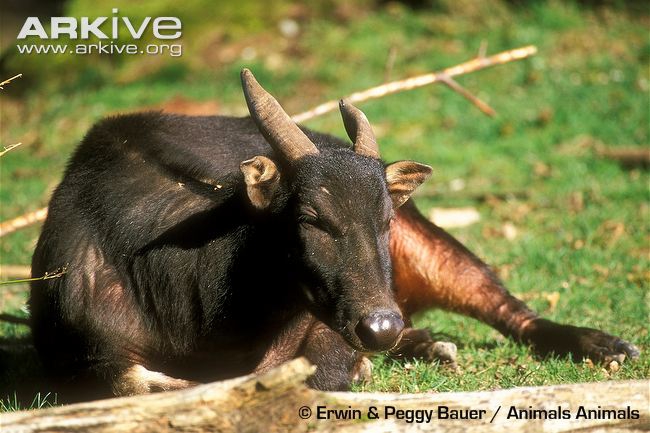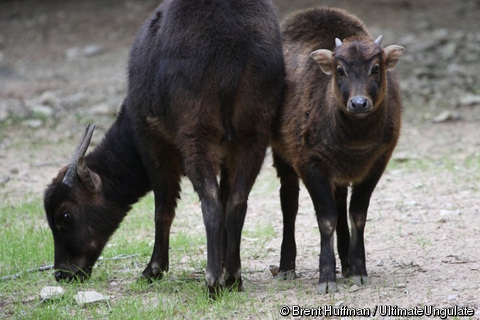| Citation |
|
Description |
Geographic Range [top]
Range Description:
This species is endemic to Indonesia, where it is found only on Sulawesi and Buton Island off the southeast coast, with no records of either species of Anoas from other small neighbouring islands adjacent to Sulawesi (Burton et al. 2005). On Sulawesi it is found up to 1,000 m (G. Semiadi pers. comm. 2006). It remains uncertain whether the two putative species, Bubalus depressicornis and Bubalus quarlesi, are sympatric or parapatric in their distribution (Burton et al. 2005). Across Sulawesi, local distribution of Anoa species remains unclear, as they may occur in forest patches at different altitudes or sympatrically (Burton et al. 2005). Records of skulls and morphological descriptions of this species suggest it is present in the northern peninsula, as far east as the Bogani Nani-Wartabone National Park. It is also found across the central region and ranging to the tip of the eastern and southeastern peninsulas, but no longer present in the southwestern peninsula. The Lowland Anoa is also present in the central and north of Buton Island (Burton et al. 2005).
Historically, Anoa of one species or other were present throughout the majority of the island’s forests (Weber 1890, Sarasin and Sarasin 1901, Mohr 1921, Harper 1945, Groves 1969, Burton et al. 2005).
Countries occurrence:
Native:
Indonesia (Sulawesi)
Additional data:
? Upper elevation limit (metres): 1000
Range Map: Click here to open the map viewer and explore range.
Population [top]
Population: There are too few data to accurately quantify the species current abundance; nevertheless, Anoa still appear to be distributed relatively widely within their known current range on Sulawesi. There have been declines of this species throughout Sulawesi, especially in the southern and northeastern peninsulas, with the decline attributed to hunting for meat and habitat loss (Indonesian Ministry of Forestry, 2013, Burton et al. 2005). The range is extremely fragmented, especially in the southern, northeastern and the south of the southeastern peninsulas of the island (Burton et al. 2005, B. Mannullang pers. comm. 2006). These declines probably began at the turn of the nineteenth century, with an increased rate of decline between 1980 and 2005 period (circa three generations), precipitously in some areas. The population size is unknown because there have been no island-wide or regional surveys which have attempted to estimate this, even for the largest populations. Estimating the population size is further complicated by the uncertain distribution of the two Anoa species. It is thought that there are fewer than 2,500 mature individuals. Most populations are becoming rapidly fragmented; suggesting that conservation of viable populations may soon require management of subpopulations (Burton et al. 2005). It is thought no subpopulation exceeds 250 mature individuals. Since the Lowland Anoa inhabits more accessible areas than the Mountain Anoa, the threats to this species, and thus the declines, are considered more serious for this species than for the Mountain Anoa.
The Lowland Anoa populations in small reserves (e.g., Tanjung Amolengu Wildlife Reserve) and other forest fragments are threatened with local extinction. Even the populations in large protected areas and other large forest blocks are reported to be in decline as a result of heavy hunting pressure. OBrien and Kinnaird (1996) report a 50 to 95% decline of this species in Tangkoko Nature Reserve in Northern Sulawesi in a 10-year period, with more recent surveys suggesting it is now locally extinct in in the reserve. The rate of population decline across their range is thought to be 20% over two generations (generation length of 7 to 9 years). The species’ ecology has been studied in the Tanjung Peropa and Tanjung Amolengo Wildlife Reserves in southeastern Sulawesi.
Current Population Trend: Decreasing
Additional data:
? Number of mature individuals: 2499 ? Continuing decline of mature individuals: Yes
? Population severely fragmented: No
? Continuing decline in subpopulations: Yes
? Extreme fluctuations in subpopulations: No ? All individuals in one subpopulation: No
Habitat and Ecology [top]
Habitat and Ecology:
There is very little is known about the ecology and life history of the Anoas (Burton et al. 2005). Population densities were estimated in south east Sulawesi where estimates range from 1.1-1.6 animals/km² but with wide confidence limits (Mustari 2003, Burton et al. 2005) and Buton where density was estimated at 1.1 animals/km² (Wheeler 2004). Further estimates are as low as 0.07 animals/km² in north Sulawesi (O’Brien and Kinnaird 1996) and as high as 2.4 animals/km² from south east Sulawesi (Mustari 1995). On Buton island, Anoas appeared to use forests independent of their primary or secondary nature, the primary determinant of use being human activity in the forest (Dwiyahreni 2006, Wheeler et al. 2009). In Lore Lindu National Park, central Sulawesi track counts were highest in higher altitude areas away from the park’s fringes (Burton and MacDonald 2009, Okarda 2010). Riverine and lowland forests were preferred by Anoa compared to rocky-cliff forest in Tanjung Peropa Wildlife Reserve due to the availability of water sources, known food plants and fruit-bearing trees (Mustari 2003). In the past the species was reportedly common along coasts. Lowland Anoa are also found at high elevations in mountainous areas. Like other wild buffalo, Anoas wallow and bathe in pools of water and/or mud. It is probable that mineral springs or licks are also required, although Anoas are reported to drink seawater, which might fulfil their mineral needs in areas without licks or springs.
The species is solitary though pairs of adults are occasionally encountered, presumably associated with breeding activity. It is a browser, feeding on low-level vegetation (Whitten et al. 2002, Foead 1992). The typical life span in captivity is reported to be 20 to 30 years, with age at sexual maturity at 2 to 3 years old (in captivity), with typically one offspring per year (NRC 1983, Jahja 1987), though in wild conditions this may be less. Generation length in captivity is between seven and nine years (Nötzold pers. comm.).
Systems: Terrestrial
Generation Length (years): 7-9
Use and Trade [top]
Use and Trade: Hunting for food is considered to be a threat to this species. There is also a trade in live animals and in body parts (presumably for medicine), but this is not thought to constitute a threat.
Threats [top]
Major Threat(s):
Land conversion to agriculture and hunting, mainly for food, are the two major threats to this species (Burton et al. 2005), as well as gold mining and other activities related to the collection of non-timber forest products (A. Priyono pers. comm. 2006). Recent reports indicate that hunting is by far the most serious threat. International trade in live animals or body parts is not thought to present a serious threat.
Conservation Actions [top]
Conservation Actions: The species is listed on CITES Appendix I and fully protected under Indonesian law (Jahja 1987). Lowland Anoa occur in a number of protected areas (Indonesian Ministry of Forestry 2013, Burton et al. 2005). There are several key protected areas thought to hold significant populations of this species, including Lore Lindu National Park, Bogani Nani-Wartabone National Park, and Tanjung Peropa Nature Reserve on Sulawesi (Indonesian Ministry of Forestry 2013, Burton et al. 2005), as well as Lambusango Wildlife Reserve on Buton Island (Burton 2001). In 2013 the Indonesian Ministry of Forestry published a Strategy and Conservation Action Plan for Anoa 2013-2022. The vision of this plan is a stable population of Anoa in its wild habitat through reduced poaching (hunting) and illegal trade, maintenance of the existing habitat, through active involvement of the stakeholders. A series of high priority sites for in situ conservation of Anoa have been identified: 11 in mainland Sulawesi, and two in Buton (Indonesian Ministry of Forestry 2013). These sites were selected based on a) representation of known subpopulations, extent of forest cover and connectivity between forested areas and status of management of area (whether sites were national parks, protected forests, restoration concessions). The plan also identifies protection from hunting, prevention of habitat loss, determining population status, education and training, and developing partnerships as important areas for future activities. It is too early to determine the impact of this new initiative. There is also on-going genetic and morphological research that aims to clarify the confusion that surrounds Anoa systematics.
A number of Lowland Anoa are in captivity, but the breeding program has been greatly hindered by the difficulties of assigning captive anoa to appropriate taxa. The captive population as of 257 animals. This consists of 46 in Europe (7th December 2015), 166 in North America and 45 in Asia (7th December 2015). In the American population, 13 individuals are in Association of Zoos and Aquariums institutions (9th December 2015) and 153 in non AZA North American institutions (pers. comm. March 2016). The sex of this latter group is not known. The sex ratio of known individuals is 43 males and 42 females. Within the Asia population of 45 individuals, 34 are kept in three Indonesian zoos (13 males and 21 females) (pers. comm. March 2016). Of these, a small number are thought to be Mountain Anoa, although the taxonomic status of most individuals remains unconfirmed (Nötzold 2013). The latest international studbook was published on 31 January 2013 (Nötzold 2013); this is currently being updated. There is a new initiative underway to implement a global species breeding programme to improve the genetic representation of the ex situ population.
Citation: Burton, J., Wheeler, P. & Mustari, A. 2016. Bubalus depressicornis. The IUCN Red List of Threatened Species 2016: e.T3126A46364222. http://dx.doi.org/10.2305/IUCN.UK.2016-2.RLTS.T3126A46364222.en. Downloaded on 12 February 2019.
Disclaimer: To make use of this information, please check the .
Feedback: If you see any errors or have any questions or suggestions on what is shown on this page, please provide us with feedback so that we can correct or extend the information provided
|


